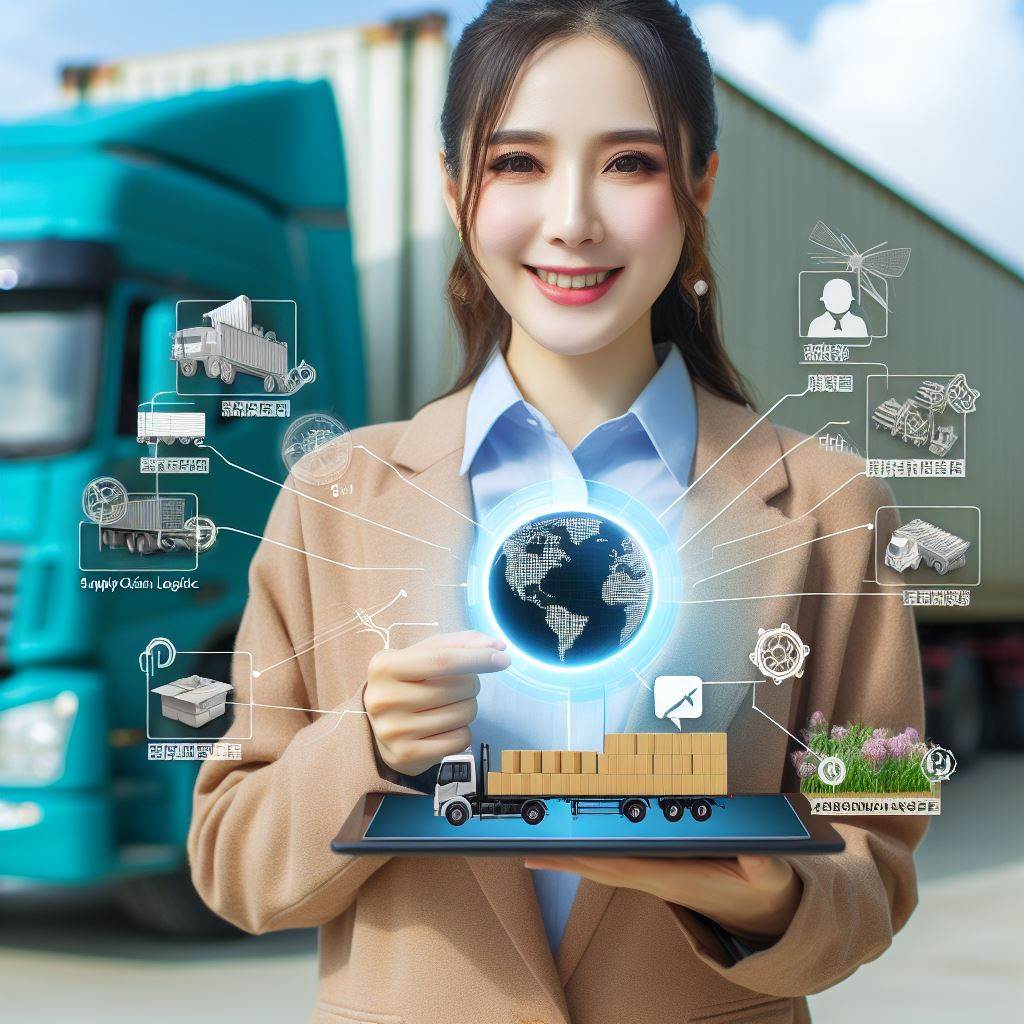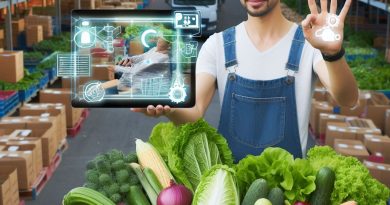Tech in Agri: Transforming Supply Chain Logistics
Last Updated on February 8, 2024
Introduction
Definition and importance of supply chain logistics in agriculture
Let’s Explore Tech in Agri: Transforming Supply Chain Logistics
Supply chain logistics in agriculture refers to the process of planning, implementing, and controlling the flow of agricultural products from the farm to the consumer.
It encompasses various activities, such as sourcing raw materials, processing, packaging, transportation, warehousing, and distribution.
The ultimate goal is to ensure the timely delivery of high-quality products to meet the demands of consumers.
Efficient supply chain logistics is essential for the agriculture industry as it enables farmers to effectively manage their operations and fulfill customer needs.
By optimizing the flow of goods, it minimizes waste, reduces costs, and enhances overall profitability.
Furthermore, it ensures that fresh and safe products reach consumers, maintaining their satisfaction and building trust in the brand.
Modern technologies have revolutionized supply chain logistics in agriculture, enabling farmers to track and monitor their products at every stage.
From using GPS systems to optimize transportation routes to employing sensors for real-time monitoring of temperature and humidity, technology plays a pivotal role in streamlining the supply chain.
Automation and data analytics allow for better demand forecasting, reducing the risk of overproduction or stockouts.
Moreover, digital platforms connect farmers directly with consumers, eliminating intermediaries and increasing transparency in pricing and product sourcing.
In general, supply chain logistics is of utmost importance in agriculture as it ensures the efficient management of agricultural products from farm to consumer.
By embracing technology and adopting innovative practices, farmers can transform their supply chain logistics, leading to increased productivity, profitability, and customer satisfaction.
Traditional supply chain logistics in agriculture
Overview of traditional processes
In traditional supply chain logistics, agriculture typically involves multiple intermediaries and manual handling of products.
Farmers harvest crops, which are then transported to collection centers or local markets using traditional transportation methods such as trucks or vans.
At the collection centers, middlemen purchase the produce from farmers and store it in warehouses or cold storage facilities.
After consolidation, the produce is further transported to wholesale markets or distribution centers by intermediaries or wholesalers.
From there, the produce is transported again to retailers or restaurants, where it finally reaches the end customers.
Challenges and limitations
Traditional supply chain logistics in agriculture face several challenges and limitations.
Lack of proper infrastructure and transportation facilities often lead to delays, wastage, and spoilage of agricultural produce.
Manual handling and multiple intermediaries result in higher costs, inefficiencies, and reduced traceability.
Inadequate cold storage facilities and poor quality control measures can negatively impact the shelf life and quality of agricultural products.
Limited access to markets, information, and advanced technologies further hinder the optimization of supply chain processes.
Impact on efficiency and productivity
The traditional supply chain logistics system in agriculture has a significant impact on efficiency and productivity.
Inefficient processes and long transit times lead to higher costs and lower profitability for farmers and other stakeholders.
The lack of transparency and traceability makes it difficult to identify and address supply chain bottlenecks or quality issues promptly.
Moreover, the traditional system often fails to meet the increasing consumer demand for freshness, quality, and sustainability in agricultural products.
It is clear that traditional supply chain logistics in agriculture require transformation and integration of technology-driven solutions to overcome the existing challenges and enhance efficiency.
Read: Agri Supply Chain: Trends in 2024 and Beyond
Role of technology in transforming supply chain logistics
The role of technology in transforming supply chain logistics in the agricultural industry cannot be underestimated.
Technological advancements have revolutionized the way agricultural products are grown, processed, and delivered to the consumers.
In this blog section, we will explore the various technological advancements and the benefits of adopting technology in agriculture.
Overview of technological advancements
- Sensors and IoT devices: Sensors and Internet of Things (IoT) devices play a crucial role in collecting real-time data on various parameters such as temperature, moisture levels, and soil quality. This data is essential for optimizing crop growth and ensuring the quality of the produce.
- Automation and robotics: Automation and robotics have transformed various aspects of agriculture, including planting, irrigation, harvesting, and packaging. These technologies improve efficiency, reduce labor costs, and ensure precision in tasks that were once performed manually.
- Data analytics and AI: Data analytics and Artificial Intelligence (AI) enable farmers to make informed decisions based on accurate and timely insights. By analyzing large volumes of data, farmers can optimize resource allocation, predict crop yields, and detect potential issues before they affect the yield.
Benefits of adopting technology in agriculture
- Improved visibility and traceability: Technology allows for real-time monitoring and tracking of agricultural products throughout the supply chain. This improves transparency, ensures food safety, and enables quick identification and resolution of any issues that may arise.
- Enhanced forecasting and inventory management: With the help of technology, farmers can accurately forecast market demand, optimize inventory levels, and prevent over or understocking. This results in improved efficiency and profitability for both farmers and retailers.
- Streamlined transportation and distribution: Technology enables efficient route planning, load optimization, and real-time tracking of shipments. This reduces transportation costs, ensures timely delivery, and minimizes product damage during transit, thereby improving customer satisfaction.
- Reduction in waste and losses: By leveraging technology, farmers can minimize post-harvest losses through optimized storage conditions, improved handling practices, and better inventory management. This not only reduces food waste but also maximizes the value of agricultural produce.
Basically, technology plays a vital role in transforming supply chain logistics in the agricultural industry.
The adoption of sensors, IoT devices, automation, robotics, data analytics, and AI leads to improved visibility, enhanced forecasting, streamlined transportation, and reduced waste and losses.
Embracing technology is crucial for the sustainable growth of the agriculture sector and meeting the demands of a rapidly changing world.
Read: Smart Farming: Revolutionizing Agri Supply Chains

Examples of tech-driven supply chain logistics solutions
Smart warehouses and distribution centers
Smart warehouses and distribution centers are revolutionizing supply chain logistics.
By utilizing advanced technologies such as the Internet of Things (IoT), robotics, and artificial intelligence (AI), these facilities can automate various processes and improve operational efficiency.
For instance, IoT devices can monitor inventory levels in real-time, ensuring that products are always in stock.
Robots can be used to automate picking, packing, and sorting tasks, reducing human error and increasing productivity.
AI algorithms can analyze data to optimize storage capacity and minimize waste.
In addition, smart warehouses can integrate with other systems like transportation management platforms, allowing for seamless coordination between different stages of the supply chain.
This integration enables real-time tracking of shipments, efficient route planning, and timely delivery, enhancing overall customer satisfaction.
Real-time monitoring systems
Real-time monitoring systems play a crucial role in ensuring supply chain transparency and efficiency.
These systems use various sensors and technologies to collect data throughout the supply chain, providing real-time visibility into operations.
For example, temperature and humidity sensors can monitor perishable goods during transportation, ensuring optimal storage conditions.
GPS tracking devices can provide real-time location updates, enabling accurate estimated arrival times and reducing delays.
Barcode scanners can track the movement of products across different stages of the supply chain, preventing loss or theft.
By having access to real-time data, businesses can proactively identify and address any issues that may arise, such as delays, stockouts, or quality problems.
This proactive approach allows for better decision-making, improved supply chain responsiveness, and ultimately, enhanced customer satisfaction.
Autonomous vehicles for transportation
The use of autonomous vehicles, including drones and self-driving trucks, is revolutionizing transportation in supply chain logistics.
These vehicles have the potential to reduce costs, increase speed, and improve overall efficiency.
Drones, for example, can be used for last-mile delivery, bypassing traffic congestion and reaching remote areas more quickly.
Self-driving trucks can optimize routes, minimize fuel consumption, and eliminate the risk of human error, leading to faster and safer deliveries.
Furthermore, autonomous vehicles can be integrated with real-time monitoring systems, providing constant updates on location, traffic conditions, and delivery status.
This integration enables businesses to have full visibility into their transportation operations, ensuring timely and efficient deliveries.
Blockchain for traceability and transparency
Blockchain technology provides a secure and transparent way of tracking and verifying transactions throughout the supply chain.
By using a decentralized and immutable ledger, blockchain can enhance traceability and transparency, addressing various challenges such as counterfeit products and supply chain fraud.
With blockchain, each transaction or movement of goods is recorded and can be traced back to its origin.
This enables businesses and consumers to verify the authenticity and legitimacy of products, ensuring quality and safety.
Additionally, blockchain allows for transparent sharing of data among supply chain partners, enabling better collaboration and trust.
Blockchain technology also enhances the efficiency of processes like payments and documentation.
Smart contracts can automate these processes, reducing paperwork and streamlining financial transactions.
This automation minimizes errors, speeds up the overall supply chain, and reduces costs.
Overall, tech-driven solutions have transformed supply chain logistics.
Smart warehouses, real-time monitoring systems, autonomous vehicles, and blockchain technology are just a few examples of how technology is enhancing efficiency, traceability, and transparency in the supply chain.
Adopting these solutions can result in improved operational performance, better customer satisfaction, and a competitive advantage in today’s dynamic business environment.
Read: New Export Markets: Strategy for Farmers
Success stories and case studies
How a farm implemented IoT sensors to optimize distribution
In a small farm located in rural Kansas, the implementation of IoT sensors revolutionized their supply chain logistics.
By placing sensors in their warehouses and delivery trucks, they were able to monitor temperature, humidity, and other environmental factors in real-time.
This data allowed them to optimize their distribution process, ensuring that produce was transported and stored under ideal conditions.
By maintaining optimal temperature and humidity, they were able to minimize spoilage and extend the shelf life of their products.
The farm also integrated the sensor data with their inventory management system, which alerted them when stocks were running low or nearing expiration.
This enabled them to plan their production and restocking activities more efficiently, reducing waste and improving customer satisfaction.
Integration of AI in inventory management for increased efficiency
A large-scale agricultural company in Brazil successfully integrated AI algorithms into their inventory management system.
By analyzing historical sales data, market trends, and weather patterns, the AI system could accurately predict demand for different products.
This enabled the company to optimize their inventory levels and reduce stockouts or excess inventory.
The AI system automatically generated purchase orders and adjusted production schedules, ensuring that the right products were available at the right time, thus increasing efficiency and profitability.
Blockchain implementation for improved traceability and trust
In the dairy industry, a major concern for consumers is the source and quality of milk.
A large dairy cooperative implemented blockchain technology to address these concerns and increase transparency.
Through the use of blockchain, each stage of the milk production and distribution process was recorded and made available to consumers.
From the farm where the milk was produced to the processing plants and finally to the store, every step was traceable and verifiable.
This implementation provided consumers with the confidence that the milk they purchased was sourced from reputable farms and met the required quality standards.
The blockchain system also allowed for quicker and more accurate recalls if any issues arose, ensuring consumer safety.
Read: US Farming: Adapting to Global Demands
Potential challenges and considerations
Initial costs and investment
Implementing tech in agri requires a significant initial investment, which may be a challenge for small-scale farmers.
The costs for purchasing and setting up advanced machinery, software, and infrastructure can be substantial.
Farmers will need to carefully assess their financial capabilities and explore funding options or partnerships.
Data privacy and security concerns
The integration of technology in supply chain logistics raises concerns about data privacy and security.
Collecting and storing sensitive information such as customer data and production records requires robust security measures.
Farmers need to employ reliable data management systems and ensure compliance with data protection regulations.
Training and skill development for farmers and workforce
Adopting technology in agriculture necessitates training and skill development for farmers and the workforce.
Many farmers may not have the necessary digital literacy skills to effectively operate technological solutions.
Providing training programs and support can help bridge the gap and ensure successful implementation.
In addition to farmers, the workforce involved in supply chain logistics will also require upskilling.
Training programs can enhance their understanding of new technologies and their applications in agri-supply chains.
Encouraging continuous skill development will enable them to adapt to evolving technological advancements.
Lastly, the integration of technology in agriculture’s supply chain logistics presents both opportunities and challenges.
While there are potential hurdles such as initial costs, data privacy concerns, and the need for training, addressing these challenges can lead to significant benefits.
Governments, organizations, and farmers must collaborate to overcome these obstacles and create a sustainable and efficient agricultural supply chain enabled by technology.
Conclusion
Recap of the impact of technology on supply chain logistics in agriculture
Advancements in technology have revolutionized supply chain logistics in agriculture, improving efficiency and transparency.
From precision farming techniques to IoT devices, technology has enabled real-time data collection, monitoring, and analysis.
This has enhanced decision-making, reduced waste, and increased productivity in the agricultural supply chain.
Future possibilities and potential advancements
The rapid pace of technological innovation in agriculture suggests even greater advancements in the future.
Artificial intelligence and machine learning algorithms have the potential to optimize supply chain operations by predicting demand, enhancing inventory management, and minimizing transportation costs.
Drones and autonomous vehicles could also play a significant role in streamlining logistics processes.
Through the continued integration of technology in agriculture, we can expect improved traceability, increased sustainability, and enhanced food safety.
Smart contracts and blockchain technology hold promise in providing transparent and secure transactions, while IoT connectivity enables seamless communication across the supply chain.
These advancements will bring about a more efficient and resilient agricultural industry.
Therefore, technology has revolutionized supply chain logistics in agriculture, driving improvements in efficiency, productivity, and sustainability.
With ongoing advancements on the horizon, the future of agri-tech in supply chain logistics looks promising, offering further benefits to farmers, suppliers, and consumers alike.


